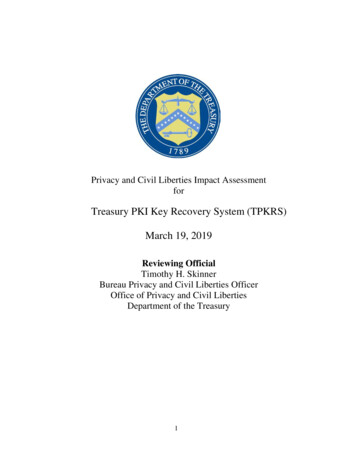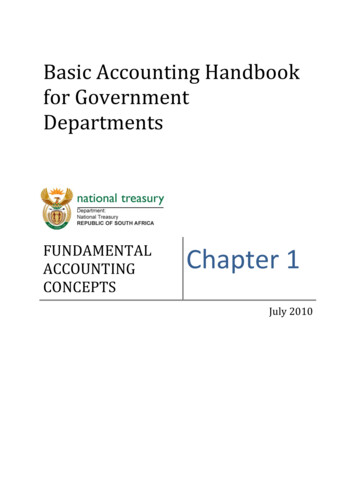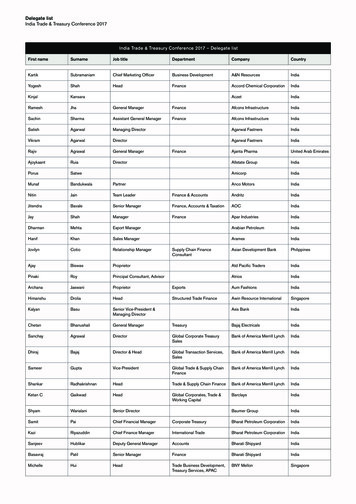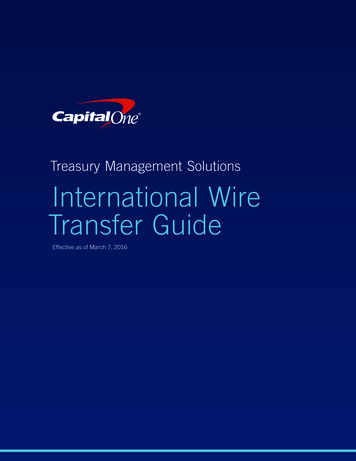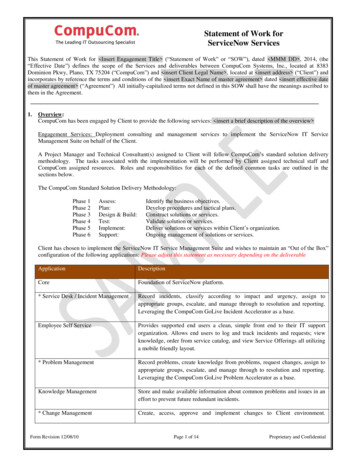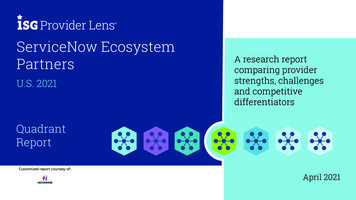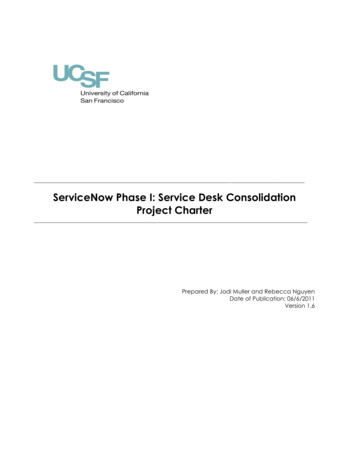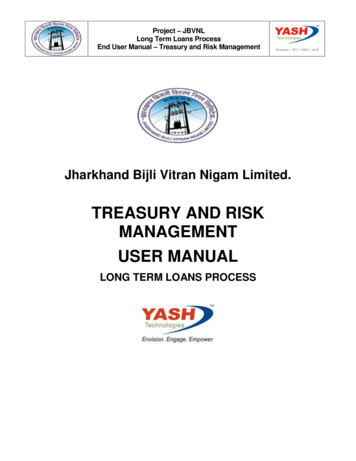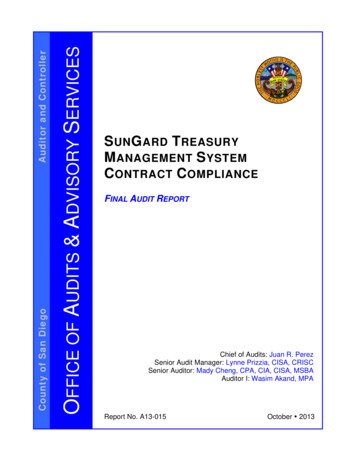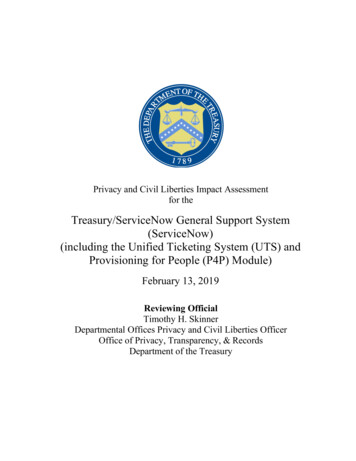
Transcription
Privacy and Civil Liberties Impact Assessmentfor theTreasury/ServiceNow General Support System(ServiceNow)(including the Unified Ticketing System (UTS) andProvisioning for People (P4P) Module)February 13, 2019Reviewing OfficialTimothy H. SkinnerDepartmental Offices Privacy and Civil Liberties OfficerOffice of Privacy, Transparency, & RecordsDepartment of the Treasury
Section 1: IntroductionIt is the policy of the Department of the Treasury (“Treasury” or “Department”) and its Bureaus toconduct a Privacy and Civil Liberties Impact Assessment (“PCLIA”) when personally identifiableinformation (“PII”) is maintained in a system or by a project. PCLIAs are required for all systemsand projects that collect, maintain, or disseminate PII, regardless of the manner in which theinformation is retrieved.This assessment is being completed pursuant to Section 208 of the E-Government Act of 2002 (“EGov Act”), 44 U.S.C. § 3501, Office of the Management and Budget (“OMB”) Memorandum 0322, “OMB Guidance for Implementing the Privacy Provisions of the E-Government Act of 2002,”and Treasury Directive 25-07, “Privacy and Civil Liberties Impact Assessment (PCLIA),” whichrequires Treasury Offices and Bureaus to conduct a PCLIA before:1. developing or procuring information technology (“IT”) systems or projects that collect,maintain, or disseminate PII from or about members of the public, or2. initiating a new collection of information that: a) will be collected, maintained, ordisseminated using IT; and b) includes any PII permitting the physical or online contactingof a specific individual, if identical questions have been posed to, or identical reportingrequirements imposed on, 10 or more persons. Agencies, instrumentalities, or employees ofthe federal government are not included.This PCLIA provides the following information regarding the system or project:(1) an overview of its purpose and functions;(2) a description of the information collected;(3) a description of the how information is maintained, used, and shared;(4) an assessment of whether the system or project is in compliance with federal requirementsthat support information privacy; and(5) an overview of the redress/complaint procedures available to individuals who may beaffected by the use or sharing of information by the system or project.This PCLIA is being conducted for the Treasury/ServiceNow General Support System for the firsttime. A Privacy Threshold Analysis (PTA) was initially completed for Treasury/ServiceNowGeneral Support System.This PCLIA covers the Treasury ServiceNow General Support System (ServiceNow), including theUnified Ticketing System (UTS) and Provisioning for People (P4P) Module.Section 2: DefinitionsAgency – means any entity that falls within the definition of the term “executive agency”' as defined in 31 U.S.C. § 102.Certifying Official – The Bureau Privacy and Civil Liberties Officer(s) who certify that all requirements in TD and TDP 25-07 have been completed so a PCLIA can be reviewed and approved by the Treasury Deputy Assistant Secretaryfor Privacy, Transparency, and Records.
Collect (including “collection”) – means the retrieval, receipt, gathering, or acquisition of any PII and its storage orpresence in a Treasury system. This term should be given its broadest possible meaning.Contractors and service providers – are private companies that provide goods or services under a contract with theDepartment of the Treasury or one of its bureaus. This includes, but is not limited to, information providers, informationprocessors, and other organizations providing information system development, information technology services, andother outsourced applications.Data mining – means a program involving pattern-based queries, searches, or other analyses of 1 or more electronicdatabases, where – (a) a department or agency of the federal government, or a non-federal entity acting on behalf of thefederal government, is conducting the queries, searches, or other analyses to discover or locate a predictive pattern oranomaly indicative of terrorist or criminal activity on the part of any individual or individuals; (b) the queries, searches,or other analyses are not subject-based and do not use personal identifiers of a specific individual, or inputs associatedwith a specific individual or group of individuals, to retrieve information from the database or databases; and (c) thepurpose of the queries, searches, or other analyses is not solely – (i) the detection of fraud, waste, or abuse in agovernment agency or program; or (ii) the security of a government computer system.Disclosure – When it is clear from its usage that the term “disclosure” refers to records provided to the public in responseto a request under the Freedom of Information Act (5 U.S.C. § 552, “FOIA”) or the Privacy Act (5 U.S.C. § 552a), itsapplication should be limited in that manner. Otherwise, the term should be interpreted as synonymous with the terms“sharing” and “dissemination” as defined in this manual.Dissemination – as used in this manual, is synonymous with the terms “sharing” and “disclosure” (unless it is clearfrom the context that the use of the term “disclosure” refers to a FOIA/Privacy Act disclosure).E-Government – means the use of digital technologies to transform government operations to improve effectiveness,efficiency, and service delivery.Federal information system – means a discrete set of information resources organized for the collection, processing,maintenance, transmission, and dissemination of information owned or under the control of a federal agency, whetherautomated or manual.Final Rule – After the NPRM comment period closes, the agency reviews and analyzes the comments received (if any).The agency has the option to proceed with the rulemaking as proposed, issue a new or modified proposal, or withdrawthe proposal before reaching its final decision. The agency can also revise the supporting analyses contained in theNPRM (e.g., to address a concern raised by a member of the public in response to the NPRM).Government information – means information created, collected, used, maintained, processed, disseminated, ordisposed of by or for the federal government.Individual – means a citizen of the United States or an alien lawfully admitted for permanent residence. If a questiondoes not specifically inquire about or an issue does not clearly involve a Privacy Act system of records, the term shouldbe given its common, everyday meaning. In certain contexts, the term individual may also include citizens of othercountries who are covered by the terms of an international or other agreement that involves information stored in thesystem or used by the project.Information – means any representation of knowledge such as facts, data, or opinions in any medium or form, regardlessof its physical form or characteristics. This term should be given the broadest possible meaning. This term includes,but is not limit to, information contained in a Privacy Act system of records.Information technology (IT) – means any equipment or interconnected system or subsystem of equipment, used in theautomatic acquisition, storage, analysis, evaluation, manipulation, management, movement, control, display, switching,interchange, transmission, or reception of data or information by the executive agency, if the equipment is used by theexecutive agency directly or is used by a contractor under a contract with the executive agency that requires the use: (i)of that equipment; or (ii) of that equipment to a significant extent in the performance of a service or the furnishing of aproduct. It includes computers, ancillary equipment (including imaging peripherals, input, output, and storage devices
necessary for security and surveillance), peripheral equipment designed to be controlled by the central processing unitof a computer, software, firmware and similar procedures, services (including support services), and related resources;but does not include any equipment acquired by a federal contractor incidental to a federal contract. Clinger-Cohen Actof 1996, 40 U.S.C. § 11101(6).Major Information system – embraces “large” and “sensitive” information systems and means “a system or projectthat requires special management attention because of its importance to an agency mission; its high development,operating, or maintenance costs; or its significant role in the administration of agency programs, finances, property, orother resources.” OMB Circular A-130, § 6.u. This definition includes all systems that contain PII and are rated as“MODERATE or HIGH impact” under Federal Information Processing Standard 199.National Security systems – a telecommunications or information system operated by the federal government, thefunction, operation or use of which involves: (1) intelligence activities, (2) cryptologic activities related to nationalsecurity, (3) command and control of military forces, (4) equipment that is an integral part of a weapon or weaponssystems, or (5) systems critical to the direct fulfillment of military or intelligence missions, but does not include systemsused for routine administrative and business applications, such as payroll, finance, logistics, and personnel management.Clinger-Cohen Act of 1996, 40 U.S.C. § 11103.Notice of Proposed Rule Making (NPRM) – the Privacy Act (Section (J) and (k)) allow agencies to use the rulemakingprocess to exempt particular systems of records from some of the requirements in the Act. This process is often referredto as “notice-and-comment rulemaking.” The agency publishes an NPRM to notify the public that the agency isproposing a rule and provides an opportunity for the public to comment on the proposal before the agency can issue afinal rule.Personally Identifiable Information (PII) –any information that can be used to distinguish or trace an individual’sidentity, either alone or when combined with other personal or identifying information that is linked or linkable to aspecific individual.Privacy and Civil Liberties Impact Assessment (PCLIA) – a PCLIA is:(1) a process conducted to: (a) identify privacy and civil liberties risks in systems, programs, and otheractivities that maintain PII; (b) ensure that information systems, programs, and other activities comply withlegal, regulatory, and policy requirements; (c) analyze the privacy and civil liberties risks identified; (d)identify remedies, protections, and alternative or additional privacy controls necessary to mitigate thoserisks; and (e) provide notice to the public of privacy and civil liberties protection practices.(2) a document that catalogues the outcome of that privacy and civil liberties risk assessment process.Protected Information – as the term is used in this PCLIA, has the same definition given to that term in TD 25-10,Section 4.Privacy Act Record – any item, collection, or grouping of information about an individual that is maintained by anagency, including, but not limited to, the individual’s education, financial transactions, medical history, and criminal oremployment history and that contains the individual’s name, or the identifying number, symbol, or other identifyingparticular assigned to the individual, such as a finger or voice print or a photograph. 5 U.S.C. § 552a (a)(4).Reviewing Official – The Deputy Assistant Secretary for Privacy, Transparency, and Records who reviews and approvesall PCLIAs as part of her/his duties as a direct report to the Treasury Senior Agency Official for Privacy.Routine Use – with respect to the disclosure of a record outside of Treasury (i.e., external sharing), the sharing of suchrecord for a purpose which is compatible with the purpose for which it was collected 5 U.S.C. § 552a(a)(7).Sharing – any Treasury initiated distribution of information to government employees or agency contractors or grantees,including intra- or inter-agency transfers or exchanges of Treasury information, regardless of whether it is covered bythe Privacy Act. It does not include responses to requests for agency records under FOIA or the Privacy Act. It issynonymous with the term “dissemination” as used in this assessment. It is also synonymous with the term “disclosure”
as used in this assessment unless it is clear from the context in which the term is used that it refers to disclosure to thepublic in response to a request for agency records under FOIA or the Privacy Act.System – as the term used in this manual, includes both federal information systems and information technology.System of Records – a group of any records under the control of Treasury from which information is retrieved by thename of the individual or by some identifying number, symbol, or other identifying particular assigned to the individual.5 U.S.C. § 552a (a)(5).System of Records Notice – Each agency that maintains a system of records shall publish in the Federal Register uponestablishment or revision a notice of the existence and character of the system of records, which notice shall include:(A) the name and location of the system; (B) the categories of individuals on whom records are maintained in the system;(C) the categories of records maintained in the system; (D) each routine use of the records contained in the system,including the categories of users and the purpose of such use; (E) the policies and practices of the agency regardingstorage, retrievability, access controls, retention, and disposal of the records; (F) the title and business address of theagency official who is responsible for the system of records; (G) the agency procedures whereby an individual can benotified at her/his request if the system of records contains a record pertaining to him; (H) the agency procedures wherebyan individual can be notified at her/his request how she/he can gain access to any record pertaining to him contained inthe system of records, and how she/he can contest its content; and (I) the categories of sources of records in the system.5 U.S.C. § 552a (e)(4).System Owner – Official responsible for the overall procurement, development, integration, modification, or operationand maintenance of a system.Section 3: System OverviewSection 3.1: System/Project Description and PurposeThis PCLIA covers the Treasury ServiceNow General Support System (ServiceNow). EnterpriseBusiness Solutions (EBS) identified ServiceNow as a cloud hosted Software as a Service (SaaS)solution that can help meet critical business and operational missions. ServiceNow is a suite ofnatively integrated applications designed to support IT service automation, resource managementand shared support services. ServiceNow is designed to support Information Technology processes,tasks, change management, and other IT processes through automation. It is a highly customizableenvironment that provides the ability for US Treasury and US Treasury customers to design andimplement applications as part of the application framework.ServiceNow is a modular solution, meaning that EBS or other Treasury customers have the abilityto use all or a subset of the applications provided by ServiceNow. A ServiceNow SaaS applicationis a group of modules, or pages, that provide related information and functionality branches. Forexample, the Incident Application contains modules for creating and viewing incidents; theConfiguration Application contains modules for configuring servers, databases, and networks.Treasury users can add or remove these SaaS applications by enabling or disabling the application’splugin. Treasury users have the ability to configure the applications to best suit the agency’s businessrequirements and increase automation of business processes.The Treasury Enterprise Unified Ticketing System (UTS) and Departmental Offices (DO)Provisioning for People (4P) are minor subdivisions in the ServiceNow General Support System.UTS and the DO P4P are business processes managed through the ServiceNow out-of-the-box
application. The UTS is implemented utilizing the ServiceNow Information Technology ServiceManagement (ITSM) software to enhance service desk agent experience by tracking customer ticketsfrom creation to closure. The application is also established to automatically route each incident tothe right person or team based on configurable data, prioritizes incidents based on business impact;service level agreements, displays real-time status of their incidents for users, and has the ability togenerate reports to inform management.DO P4P is an onboarding request application that allows hiring managers the ability to ensure thenecessary resources and equipment are in place on the new hire’s entrance on duty date. Thismaximizes productivity with a positive user experience. DO P4P also handles the collection ofequipment and deactivating account privileges for employee’s who are exiting Treasury. Thecreation of DO P4P in ServiceNow removes manual steps and automates the process, which reducesthe administrative oversight, ensures that all required approvals are received and new users haveaccess to the applications, devices, and systems they need before the new user starts on their firstday.Provisioning requests are objects in a digital directory that include business rules for determiningthe order in which a request for resources is processed. Provisioning requests consist of Entry,Relocation and Exit. The Entry provisioning requests include the selection of informationtechnology such as laptop, telephone, mobile device, LAN account; facilities for work space andmiscellaneous items such as travel card and purchase card to name a few. The Relocation Requestmoves a single person or team from one workspace to another while the Exit Request recoups theequipment that initially was assigned to an exiting employee for accountability purposes. For eachrequest, automatic notifications are sent to the appropriate offices for their action. For both, UTSand DO P4P authorized users are only able to access applications using their personal identityverification card or they must have authenticated in the HRConnect system to sign in with theircredentials.The Office of the Chief Information Officer’s (OCIO) EBS organization provides leadership to theU.S. Department of Treasury and its Bureaus in all areas of information and technology managementand supports Treasury's mission by implementing strategies that improve the efficiency andperformance of Treasury information technology systems and business processes. OCIO hasDepartment-wide responsibility for the direction and development of Treasury’s informationtechnology strategy, management of information technology investments, and leadership of keytechnology initiatives.Estimated Number of Individuals Whose Personally Identifiable Information isMaintained in the System or by the Project 0 – 999 1,000 – 9,999 10,000 – 99,999 100,000 – 499,999 500,000 – 999,999 1,000,000 Section 3.2: Authority to CollectThe authorities for operating this system or performing this project are: 5 U.S.C. 301 - Department regulations for the operations of the department, conduct of employees,distribution and performance of its business, the custody, use, and preservation of its records, papers,and property.
31 U.S.C. 321 - General authorities of the Secretary establish the mission of the Department of the Treasury.Section 4: Information CollectionSection 4.1: Relevant and NecessaryThe Privacy Act requires “each agency that maintains a system of records [to] maintain in its recordsonly such information about an individual as is relevant and necessary to accomplish a purpose ofthe agency required to be fulfilled by statute or by executive order of the President.” 5 U.S.C. § 552a(e)(1). It allows federal agencies to exempt records from certain requirements (including the relevantand necessary requirement) under certain conditions. 5 U.S.C. § 552a (k). The proposed exemptionmust be described in a Notice of Proposed Rulemaking (“NPRM”). In the c
Treasury/ServiceNow General Support System (ServiceNow) (including the Unified Ticketing System (UTS) and . 44 U.S.C. § 3501, Office of the Management and Budget (“OMB”) Memorandum 03- . – are private companies that provide goods or services under a contract with the Department of the Treasury or one of its bureaus. This includes .

